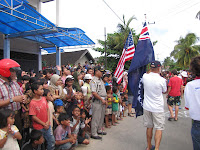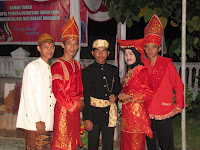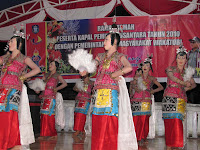 here. As a result, this city of 250,000 pulled out all the stops for our group. The dragon at the right overlooks the harbor where we are anchored, and at night his eyes are lit with red lights--pretty scary looking.
here. As a result, this city of 250,000 pulled out all the stops for our group. The dragon at the right overlooks the harbor where we are anchored, and at night his eyes are lit with red lights--pretty scary looking.
We arrived at dusk on the 21st. It was sprinkling rain, and the anchorage was a bit full, but we finally found a small spot. We dropped the anchor and waited. It was not holding, so we re-anchored, and this time it held. We were a little tired, so sv Esprit invited Tin Soldier and us over for drinks and appetizers.
The next day a trip to a cave was scheduled in the morning, and a pedi-bike ride (a rickshaw powered by a bicycle) was scheduled for the afternoon. We did not attend the cave because we had to mend a seam on the dinghy. Around noon we went ashore, leaving our dinghy at the temporary dinghy dock, and enjoyed lunch. While we were there, the wind came up, and it looked pretty rough in the anchorage. We hurried back after lunch to find our dinghy pulled up onto the dock along with several others. The waves were coming over the dock, which was getting pounded against the stone steps by the waves coming into shore. The guys watching the dinghy dock helped us get the dinghy back into the water, and we made a hasty retreat back to the boat.
When we were back on board, we discovered that we were too close to another boat, so we pulled the anchor and moved--again. We had planned to attend the pedi-bicycle ride; however, with the rough conditions and having just moved the boat, we decided to stay aboard to make sure that the anchor was holding. The current here creates real problems here because it affects the position of the mono-hull sailboats, but the wind affects the position of the catamarans so we all moved in different directions. Several boats have bumped each other during our stay. Luckily, we are not one of those.
 The next day was a very busy one. In the morning we were taken by bus, with a police escort with the sirens blaring, to Nirwana Beach to enjoy some swimming and snorkeling. Unfortunately, it began to rain after two hours so we returned to the anchorage.
The next day was a very busy one. In the morning we were taken by bus, with a police escort with the sirens blaring, to Nirwana Beach to enjoy some swimming and snorkeling. Unfortunately, it began to rain after two hours so we returned to the anchorage.
At 3:30 we returned to shore to attend the welcome ceremony that was planned by the locals. The elders were there, and all were dressed in their traditional clothing. Five of them sat on a blanket and prepared water for a blessing on us. Each cruiser then knelt in front of each elder, shook his hand, and then moved on. The last two elders dipped leaves into the water and then sprinkled it on our heads. After that we received a lei made of flowers, and then we walked between two lines of the other representatives from the area. There must have been 50 men, and we shook every man’s hand. The welcome that we received was really quite impressive.
Next we got back into the buses and were again escorted to a handicraft shop where there was weaving, jewelry making, and sewing of the very decorative cloths for the traditional costumes. Across the street we entered a traditional house that was built on stilts, and we were given a tour. In the rear room, we were allowed to put on the headdress and jackets that are worn for a wedding, and we had our picture taken. It was great fun.
The Keraton Fortress was our next stop. This fortress sits high on the hill overlooking Bau-Bau, and this palace fortress is
was our next stop. This fortress sits high on the hill overlooking Bau-Bau, and this palace fortress is  recorded as the largest fortress in the world with a length of 2.74 km. It was begun in 1591 and was finished sometime around 1645. There are quite a few homes inside the perimeter walls of the fort, and some government buildings as well. It was quite impressive and in good condition as it has been restored.
recorded as the largest fortress in the world with a length of 2.74 km. It was begun in 1591 and was finished sometime around 1645. There are quite a few homes inside the perimeter walls of the fort, and some government buildings as well. It was quite impressive and in good condition as it has been restored.
Within the fort, we went to Keraton Hall, where some local dances were performed for us. Inside the hall, there were families from all the different villages, and they had all prepared their traditional food dishes for us. Steve and I sat with one family—a mother, her sister, and her daughter Amy, and a friend of Amy’s. They served us portions of at least 10 different items, all of which were just wonderful. There was fish, chicken, lobster, crab, several types of rice, banana and coconut custard, and sweet treats. I don’t know the names of all the dishes, but all of them were the most delicious foods we have had here in Indonesia, and it was obvious that they had spent days preparing the food. Amy spoke very good English so we learned quite a bit about her family and the traditional foods.
preparing the food. Amy spoke very good English so we learned quite a bit about her family and the traditional foods.
 During dinner, some young children walked through the hall dressed in traditional wear, and they were absolutely adorable. After dinner, the locals all wanted pictures with us. We must have had 50 pictures taken of us--it was really amazing. We left the hall so full that we could hardly breathe and returned to the buses to head back to the boat. Everyone on the ride back said that they were overwhelmed with our reception and many were moved to tears, including us.
During dinner, some young children walked through the hall dressed in traditional wear, and they were absolutely adorable. After dinner, the locals all wanted pictures with us. We must have had 50 pictures taken of us--it was really amazing. We left the hall so full that we could hardly breathe and returned to the buses to head back to the boat. Everyone on the ride back said that they were overwhelmed with our reception and many were moved to tears, including us.
Tuesday began with a bus trip north to a Hindu village where everyone turned out to  warmly greet us and where we were treated to three Balinese dances. The locals provided us with a delicious lunch, and then we were off to see the rice fields. The Balinese people came to Bau-Bau 30 years ago, installed a dam and irrigation system, and cleared the land by hand. The rice fields are quite impressive, and the landscape was beautiful.
warmly greet us and where we were treated to three Balinese dances. The locals provided us with a delicious lunch, and then we were off to see the rice fields. The Balinese people came to Bau-Bau 30 years ago, installed a dam and irrigation system, and cleared the land by hand. The rice fields are quite impressive, and the landscape was beautiful.
That evening the Mayor invited all of us to his home and put on an amazing dinner and presentation of local custom dances. One of the dances is actually named the "Linda Dance."  Bernie and Diane on sv First Light III volunteered to wear traditional outfits for the event, and they gave a speech thanking the mayor and the Sail Banda committee for all their hard work. After dinner all the cruisers were taken by a local to dance. None of us seemed to grasp the steps, but we provided some entertainment. Then there was the usual line dance to local music, so I enjoyed participating in that for awhile. We left around midnight, once again tired
Bernie and Diane on sv First Light III volunteered to wear traditional outfits for the event, and they gave a speech thanking the mayor and the Sail Banda committee for all their hard work. After dinner all the cruisers were taken by a local to dance. None of us seemed to grasp the steps, but we provided some entertainment. Then there was the usual line dance to local music, so I enjoyed participating in that for awhile. We left around midnight, once again tired  but pleased with all we had seen that day.
but pleased with all we had seen that day.
Yesterday was very busy with shopping for vegetables and fruit at the central market and the MGM supermarket. Marilyn and I rode motorcycle taxis to the MGM, which was a real experience because of all the traffic here. Three of us ladies found a few hours in the afternoon to go shopping for clothes. In the late afternoon we hosted a happy hour for Esprit and Tin Soldier, and then we joined Tin Soldier ashore for dinner.
Today we will take care of any loose ends and last minute shopping. We plan to leave in the morning to head south to Flores Island, stop at Bone Raté reef for a day or two in order to break up the passage, and then hook up with the southern group of Sail Indonesia. Bau-Bau has been an absolutely wonderful experience, and we are so glad that we came here to enjoy its hospitality and meet the people.



.jpg)
.jpg)



.jpg)
.jpg)
.jpg)




.bmp)